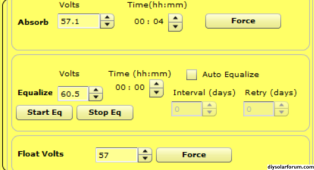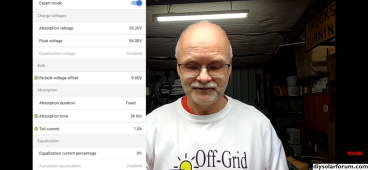Howdy,
Our resident Midnite Classic expert is Steve_S
Scan for his articles, especially the 'My final config for Midnite Classic'
Excellent, fully explained, step by step instructions.....
I've owned Midnite Classics forever and still learned a few new tips from him...
Enjoy..
I think I found it. I am pasting it here incase someone else would like to read it:
INTRO: I have debated posting this for a while until I got everything tweaked in and working as best as possible.
The End Result is Gobsmackingly Good !
I cannot speak for other SCC and such as each is different & unique in their own ways BUT this may likely be a Good Reference.
Civility & Politeness is required in this thread.
My FINAL Tweaked out settings, NOTE this is for 24V system, Using a Midnite Classic 200 (not really designed for Lithium Based due to single decimal point accuracy. I am also posting the JKBMS Settings which by the time the packs enter Float Mode they are very nicely Balanced.
Important FYI, Active Balancing Quick Guideline is 1A Balancing per 100AH / 200AH - 2A Balancing / 300AH - 3A and so on.
Midnite Classic Charge Controller Settings (Effective since Finalized build June 2022)
All equipment MUST BE Voltage Corrected & Calibrated (VERY IMPORTANT)
Divide Values X2 for 12V. Multiply X2 for 48V.
Absorb: 27.6 for 45 minutes (3.45vpc)
(some call this boost) *I run a Bank of 5 packs, but never actually runs the full 45mins because of EndAmps
Equalize: OFF
Float 27.5V (3.437vpc)
MIn Volts: 21.2 (2.650vpc)
Max Volts: 28.6 (3.575vpc)
Rebulk Voltage: 25.6 (3.200vpc)
End Amps: 8.7A (*1) (** Using WizbangJr Smartshunt to control) (*** Allows for full Saturation at set Float Voltage)
(*1): End Amps is calculated from the
LOWEST AH Battery Pack in a Bank. IE: (100AH X 0.05 = 5A 280AH X 0.05 = 14A. My Smallest 174AH is 8.7A)
NB: Victron Forum discussion says EndAmps = TailCurrent
Coulumbic Efficiency / Battery Status Meter Efficiency for LFP = 99%.
This get's the bank charged to full with high amps (Constant Current) and then float (Constant Voltage) tops off so the cells are at 3.47Vpc. I am running 7/24/365 so float is used up by the Inverter + provides whatever the packs will take to top off. (which is minimal)
* Do Not forget to adjust for Voltage Offsets between Actual Voltage @ Battery Terminal & at Solar Controller.
Very Special NOTE: Floating & Saturating to 3.437vpc, accounts for the Voltage Settling post Charge of any kind which actually brings the cells to just below 3.400Vpc.
EDIT - July 7 2022.
 Voltage Corrected & Calibrated (VERY IMPORTANT)
Voltage Corrected & Calibrated (VERY IMPORTANT)
- Midnite Solar Classics SCC's can be programmed for OFFSETS.
- Not all are capable so to adjust values it will have to be in charging values AS WELL as your Inverter/Charger.
- Even 0.1 Volt offset Can & Will affect operations
The simplest Way
Use 2 or 3 Decimal Accurate DVOM/DMM.
While SCC is Charging, Measure the Real Voltage coming out of the SCC and write it down, Same for the Inverter/Charger @ its BATT Terminal.
When Batts are in a + Charge (NOT when Discharging) measure the Voltage @ its/their Battery Terminal Lugs.
There WILL be some variances but there is always some Line Loss between these devices, Most important is what is going into the BATT.
Check your notes from each test. That Differential in Voltage must be Compensated for !
Take that Voltage Offset and apply it to the SCC, either an Offset Function or by the Charge Settings
IE, Assume SCC to Batt Terminal is 0.1V and you are Charging, Bulk/Absorb/Float Adjust the values UP. IE If Absorbing @ 27.6V increase that to 27.7V to compensate and the other Values as well. DO NOT FORGET to do the same for Low Voltage Disconnect !
The Inverter Needs two values;
The Charging Voltage offset applied as Above You got that value in your tests above. With SCC Charging.
Low Voltage Disconnect. MUST BE Measured when No SCC Charging is happening and the inverter is drawing from BATT only. It will be different than when SCC is charging the batts. Use that to adjust for Low Volt Disconnect ! Or you may get a Late Disconnect @ Low Volts making the disconnect lower than you set. NOT A GOOD THING !
Lastly, be aware that every Fuse/Breaker, Lug & Batt terminal adds to Voltage Drop collectively due to resistance.
---- End of Edit ----
What is a WizBangJr ?
| Description: | The Whiz Bang Jr is a current sense module that attaches to the standard 50mv / 500A Shunt (MNSHUNT) and wires into the Classic and KID charge controllers to give Amperage readings from the shunt. To use the Whizbang jr (MNWBjr) with any of the Classic Lites, you will either need the local app or an MNGP. |
* Sadly designed for Lead Acid Chemistries and therefore
only Single Decimal Point Accuracy. Similar higher Accuracy Smartshuts like Victron (2 decimal point accuracy) can also perform similar functions for various SCC's. The SmartShunts from Victron are good.
JKBMS SETTINGS (warning, long) BELOW the Main BMS status screens showing the Delta between cells in ALL Packs. 2 Shown.
ATM that is 2x174AH Used EV Grade LFP & 2x280AH ESS Grade (what many call Bulk or B grade)






